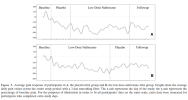Evergreen
Senior Member (Voting Rights)
Thought we should have a thread for this trial as it is often cited as evidence of efficacy of LDN in fibromyalgia.
Randomized Controlled Trial
Arthritis Rheum. 2013 Feb;65(2):529-38. doi: 10.1002/art.37734.
Methods: Thirty-one women with fibromyalgia participated in the randomized, double-blind, placebo-controlled, counterbalanced, crossover study. During the active drug phase, participants received 4.5 mg of oral naltrexone daily. An intensive longitudinal design was used to measure daily levels of pain.
Results: When contrasting the condition end points, we observed a significantly greater reduction of baseline pain in those taking low-dose naltrexone than in those taking placebo (28.8% reduction versus 18.0% reduction; P = 0.016). Low-dose naltrexone was also associated with improved general satisfaction with life (P = 0.045) and with improved mood (P = 0.039), but not improved fatigue or sleep. Thirty-two percent of participants met the criteria for response (defined as a significant reduction in pain plus a significant reduction in either fatigue or sleep problems) during low-dose naltrexone therapy, as contrasted with an 11% response rate during placebo therapy (P = 0.05). Low-dose naltrexone was rated equally tolerable as placebo, and no serious side effects were reported.
Conclusion: The preliminary evidence continues to show that low-dose naltrexone has a specific and clinically beneficial impact on fibromyalgia pain. The medication is widely available, inexpensive, safe, and well-tolerated. Parallel-group randomized controlled trials are needed to fully determine the efficacy of the medication.
Trial registration: ClinicalTrials.gov NCT00568555.
Copyright © 2013 by the American College of Rheumatology.
Link to abstract
Randomized Controlled Trial
Arthritis Rheum. 2013 Feb;65(2):529-38. doi: 10.1002/art.37734.
Low-dose naltrexone for the treatment of fibromyalgia: findings of a small, randomized, double-blind, placebo-controlled, counterbalanced, crossover trial assessing daily pain levels
Jarred Younger, Noorulain Noor, Rebecca McCue, Sean Mackey- PMID: 23359310
- DOI: 10.1002/art.37734
Abstract
Objective: To determine whether low dosages (4.5 mg/day) of naltrexone reduce fibromyalgia severity as compared with the nonspecific effects of placebo. In this replication and extension study of a previous clinical trial, we tested the impact of low-dose naltrexone on daily self-reported pain. Secondary outcomes included general satisfaction with life, positive mood, sleep quality, and fatigue.Methods: Thirty-one women with fibromyalgia participated in the randomized, double-blind, placebo-controlled, counterbalanced, crossover study. During the active drug phase, participants received 4.5 mg of oral naltrexone daily. An intensive longitudinal design was used to measure daily levels of pain.
Results: When contrasting the condition end points, we observed a significantly greater reduction of baseline pain in those taking low-dose naltrexone than in those taking placebo (28.8% reduction versus 18.0% reduction; P = 0.016). Low-dose naltrexone was also associated with improved general satisfaction with life (P = 0.045) and with improved mood (P = 0.039), but not improved fatigue or sleep. Thirty-two percent of participants met the criteria for response (defined as a significant reduction in pain plus a significant reduction in either fatigue or sleep problems) during low-dose naltrexone therapy, as contrasted with an 11% response rate during placebo therapy (P = 0.05). Low-dose naltrexone was rated equally tolerable as placebo, and no serious side effects were reported.
Conclusion: The preliminary evidence continues to show that low-dose naltrexone has a specific and clinically beneficial impact on fibromyalgia pain. The medication is widely available, inexpensive, safe, and well-tolerated. Parallel-group randomized controlled trials are needed to fully determine the efficacy of the medication.
Trial registration: ClinicalTrials.gov NCT00568555.
Copyright © 2013 by the American College of Rheumatology.
Link to abstract
Last edited:

